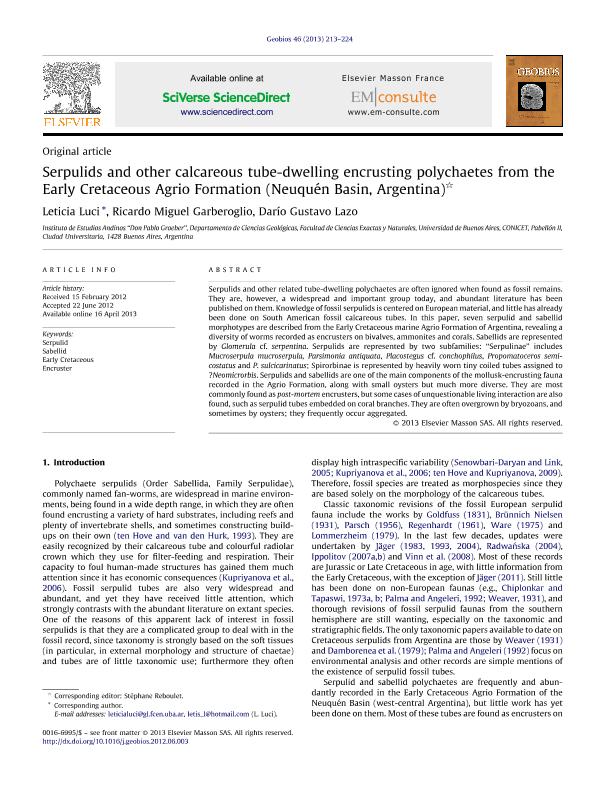Mostrar el registro sencillo del ítem
dc.contributor.author
Luci, Leticia

dc.contributor.author
Garberoglio, Ricardo Miguel
dc.contributor.author
Lazo, Dario Gustavo

dc.date.available
2017-01-17T17:48:01Z
dc.date.issued
2013-06
dc.identifier.citation
Luci, Leticia; Garberoglio, Ricardo Miguel; Lazo, Dario Gustavo; Serpulids and other calcareous tube-dwelling encrusting polychaetes from the Early Cretaceous Agrio Formation (Neuquén Basin, Argentina); Elsevier; Geobios; 46; 3; 6-2013; 213-224
dc.identifier.issn
0016-6995
dc.identifier.uri
http://hdl.handle.net/11336/11469
dc.description.abstract
Serpulids and other related tube-dwelling polychaetes are often ignored when found as fossil remains. They are, however, a widespread and important group today, and abundant literature has been published on them. Knowledge of fossil serpulids is centered on European specimens, and little has been done on South American fossil calcareous tubes. In this paper, seven serpulid and sabellid morphotypes are described from the Early Cretaceous marine Agrio Formation of Argentina, revealing a diversity of worms recorded as encrusters on bivalves, ammonites and corals. Sabellids are represented by Glomerula cf. serpentina. Serpulids are represented by two subfamilies: "Serpulinae" includes Mucroserpula mucroserpula, Parsimonia antiquata, Placostegus cf. conchophilus, Propomatoceros semicostatus and P. sulcicarinatus; Spirorbinae is represented by heavily worn tiny coiled tubes assigned to Neomicrorbis?. Serpulids and sabellids are one of the main components of the mollusk encrusting fauna recorded in the Agrio Formation, along with small oysters but much more diverse. They are most commonly found as post-mortem encrusters, but some cases of unquestionable living interaction were also found, remarkably serpulid tubes embedded on coral branches. They are often overgrown by bryozoans, and sometimes by oysters, and frequently occur aggregated.
dc.format
application/pdf
dc.language.iso
eng
dc.publisher
Elsevier

dc.rights
info:eu-repo/semantics/openAccess
dc.rights.uri
https://creativecommons.org/licenses/by-nc-nd/2.5/ar/
dc.subject
Serpulidae
dc.subject
Sabellidae
dc.subject
Neuquén
dc.subject
Cretácico Temprano
dc.subject.classification
Paleontología

dc.subject.classification
Ciencias de la Tierra y relacionadas con el Medio Ambiente

dc.subject.classification
CIENCIAS NATURALES Y EXACTAS

dc.title
Serpulids and other calcareous tube-dwelling encrusting polychaetes from the Early Cretaceous Agrio Formation (Neuquén Basin, Argentina)
dc.type
info:eu-repo/semantics/article
dc.type
info:ar-repo/semantics/artículo
dc.type
info:eu-repo/semantics/publishedVersion
dc.date.updated
2016-12-12T21:06:07Z
dc.journal.volume
46
dc.journal.number
3
dc.journal.pagination
213-224
dc.journal.pais
Francia

dc.journal.ciudad
Paris
dc.description.fil
Fil: Luci, Leticia. Consejo Nacional de Investigaciones Científicas y Técnicas. Oficina de Coordinación Administrativa Ciudad Universitaria. Instituto de Estudios Andinos; Argentina. Universidad de Buenos Aires. Facultad de Ciencias Exactas y Naturales. Departamento de Ciencias Geológicas; Argentina
dc.description.fil
Fil: Garberoglio, Ricardo Miguel. Consejo Nacional de Investigaciones Científicas y Técnicas. Oficina de Coordinación Administrativa Ciudad Universitaria. Instituto de Estudios Andinos; Argentina. Universidad de Buenos Aires. Facultad de Ciencias Exactas y Naturales. Departamento de Ciencias Geológicas; Argentina
dc.description.fil
Fil: Lazo, Dario Gustavo. Consejo Nacional de Investigaciones Científicas y Técnicas. Oficina de Coordinación Administrativa Ciudad Universitaria. Instituto de Estudios Andinos; Argentina. Universidad de Buenos Aires. Facultad de Ciencias Exactas y Naturales. Departamento de Ciencias Geológicas; Argentina
dc.journal.title
Geobios

dc.relation.alternativeid
info:eu-repo/semantics/altIdentifier/doi/http://dx.doi.org/10.1016/j.geobios.2012.06.003
dc.relation.alternativeid
info:eu-repo/semantics/altIdentifier/url/http://www.sciencedirect.com/science/article/pii/S0016699513000296
Archivos asociados
